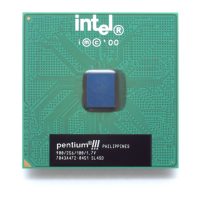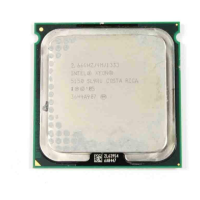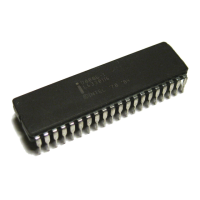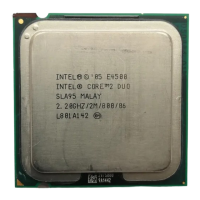20 Datasheet
Electrical Specifications
2.5 Reserved, Unused, FC and TESTHI Signals
All RESERVED signals must remain unconnected. Connection of these signals to V
CC
, V
SS
, V
TT,
or to any other signal (including each other) can result in component malfunction or
incompatibility with future processors. See Chapter 4 for a land listing of the processor and the
location of all RESERVED signals.
For reliable operation, always connect unused inputs or bidirectional signals to an appropriate
signal level. In a system level design, on-die termination has been included on the Pentium 4
processor in the 775-land package to allow signals to be terminated within the processor silicon.
Most unused GTL+ inputs should be left as no connects, as GTL+ termination is provided on the
processor silicon. However, see Table 2-4 for details on GTL+ signals that do not include on-die
termination. Unused active high inputs should be connected through a resistor to ground (V
SS
).
Unused outputs can be left unconnected, however this may interfere with some test access port
(TAP) functions, complicate debug probing, and prevent boundary scan testing. A resistor must be
used when tying bidirectional signals to power or ground. When tying any signal to power or
ground, a resistor will also allow for system testability. For unused GTL+ input or I/O signals, use
pull-up resistors of the same value as the on-die termination resistors (R
TT
). Refer to Table 2-18 for
more details.
TAP, GTL+ Asynchronous inputs, and GTL+ Asynchronous outputs do not include on-die
termination. Inputs and used outputs must be terminated on the system board. Unused outputs may
be terminated on the system board or left unconnected. Note that leaving unused outputs
unterminated may interfere with some TAP functions, complicate debug probing, and prevent
boundary scan testing.
FCx signals are signals that are available for compatibility with other processors.
The TESTHI signals must be tied to the processor V
TT
using a matched resistor, where a matched
resistor has a resistance value within ±20% of the impedance of the board transmission line traces.
For example, if the trace impedance is 60 Ω, then a value between 48 Ω and 72 Ω is required.
The TESTHI signals may use individual pull-up resistors or be grouped together as detailed below.
A matched resistor must be used for each group:
• TESTHI[1:0]
• TESTHI[7:2]
• TESTHI8 – cannot be grouped with other TESTHI signals
• TESTHI9 – cannot be grouped with other TESTHI signals
• TESTHI10 – cannot be grouped with other TESTHI signals
• TESTHI11 – cannot be grouped with other TESTHI signals
• TESTHI12 – cannot be grouped with other TESTHI signals
• TESTHI13 – cannot be grouped with other TESTHI signals

